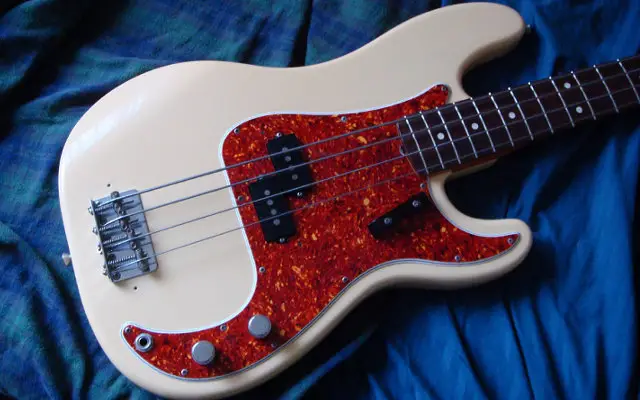I’ve always thought that there was something mysterious and
fascinating about the original Fender custom colors. Partly because of
the history but also because of the misconceptions and myths.
There
is a lot of confusion and misunderstanding about what colors were
available and when they were originally offered. There are even some
colors that didn’t even really exist at all. And when it comes to the
actual finish types it can get even more confusing.
The first thing to understand is what type of finishes Fender was using during the late 1950’s and early 1960’s.
All of the original custom colors were based on automotive colors available at the time from the big car manufacturers. Fender was simply using the same finishes that were supplied to those companies for its own instruments.
Originally Fender only did custom colors upon request and the customer could choose whatever color they wanted, a truly custom color option. But in 1958 Fender standardized all their custom colors and what they offered was what you had to choose from.
Fender’s main supplier at the time was DuPont, which used two basic types of finishes. Duco: a brand name for nitrocellulose lacquer and Lucite: a brand name for acrylic lacquer. Depending on the color either one of these finishes was used on Fender instruments. Now I know what many have must be thinking, “I thought Fender only used nitrocellulose lacquer back then.” Well, they didn’t. Classic custom colors like Olympic White, Lake Placid Blue, and Burgundy Mist were acrylic lacquers.
Keep in mind that we’re talking about the color coat only and both of these finishes were lacquers. Nitrocellulose lacquer uses a celluloid based binder and acrylic lacquer uses an acrylic based binder. Fender then covered both types of coats with a nitrocellulose clear coat, so yes Fender did technically use nitrocellulose on all its basses back then…usually.
There have been some cases when Fender didn’t use the nitrocellulose clear top coat on certain basses. Most likely these were rush jobs and that step was skipped depending on the color and how fast they needed the bass. A few Olympic White basses never received the nitro top coat and as a result, they didn’t yellow like most do as they aged, instead of keeping their original white finish to this day. Most of these examples tend to be from the early 1960s.
Remember that the Olympic white base coat was an acrylic lacquer and therefore did not yellow over time, however, most of those Fenders got the clear nitro top coat over the white which would yellow the color significantly over time, mostly due to UV light, smoke,
Color Changes
The only basses were this never happened were ones finished with a metallic color. All metallic finishes had to have the clear nitro top coat otherwise the paint would oxidize very quickly. The non-metallic
The tendency for vintage colors to change over time as led to one of the biggest Fender custom color mysteries of all. Coral or Coral Pink and Salmon Pink have been rumored for years to be rare Fender custom colors, only turning up now and then. In reality, Fender never offered these colors, they were most likely Fiesta Red (which has lots of pink in it) that had faded over the years and turned a much lighter shade.
Keep in mind that Fender did not always use the exact same paint every year or even every month. Although the paints were originally supplied by DuPont and all the color chips that were used as a reference were from DuPont, Fender would use whatever paint supplier was the best deal at the time. So even though they matched the paint as best they could to the color chips some colors varied a little over the years.
Another interesting thing about the custom colors is which bodies Fender would choose for them. Generally speaking, Fender would try to use bodies that had less than stellar wood grain. As most of the standard basses back then were sunburst finishes and the wood grain would be seen, Fender,
But that was not always the case. If Fender was in a hurry, or if there was a botched sunburst finish handy (and there it was), they would sometimes spray a custom color right over a sunburst body.
Fender Vintage Custom Colors 1958-73 (*)Metallic color
Black (Duco) 1958-Present
Burgundy Mist* (Lucite) 1960-65
Candy Apple Red* (N/A) 1963-73
Charcoal Frost* (Lucite) 1965-69
Dakota Red (Duco) 1960-69
Daphne Blue (Duco) 1960-65
Fiesta Red (Duco) 1960-69
Firemist Gold* (Lucite) 1965-71
Firemist Silver* (Lucite) 1965-71
Ice Blue* (Lucite) 1965-69
Inca Silver* (Lucite) 1960-65
Lake Placid Blue* (Lucite) 1960-73
Ocean Turquoise* (Lucite) 1965-71
Olympic White (Lucite) 1958-Present
Sea Foam Green (Duco) 1960-69
Shell Pink (Duco) 1960-63
Sherwood Green* (Duco) 1960-65
Shoreline Gold* (Lucite) 1960-65
Sonic Blue (Duco) 1960-72
Surf Green (Duco) 1960-65
Teal Green* (Lucite) 1965-69

